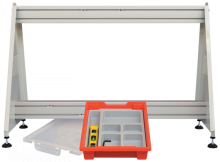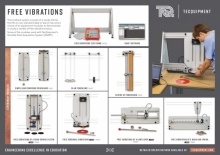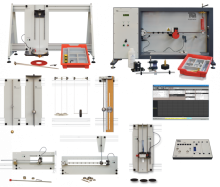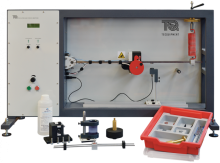Free Vibrations Test Frame


A sturdy bench top frame for use with the Free Vibrations experiment modules.
This product is part of a range that explores free vibrations in simple ‘one degree of freedom’ systems.
It introduces students to key scientific terms such as:
This product fits to the sturdy Test Frame (TM160) for study or demonstration.
A center of percussion may also be termed the ‘sweet spot’ of the impact of a ball against a bat or racquet. It is the impact position that allows no reaction in the hand of the user, which would otherwise create uncomfortable shocks in their arm and wrist.
This product includes a metal pendulum to provide the percussion force (a ball) and a wooden pendulum to absorb the impact. The wooden pendulum forms a suspended mass, similar to a bat held underhand.
A cradle fixes to the top of the Test Frame. The cradle suspends the fixed metal rod pendulum and heavy sphere beside the wooden pendulum.
Self-aligning bearings hold the metal pendulum to allow rotational movement only.
Hardened steel knife edges rest on a smooth surface on the cradle suspending the wooden pendulum. They allow the wooden pendulum to pivot freely while also allowing some visible horizontal movement, necessary to see any reactions.
Students find the center of gravity of the wooden (compound) pendulum to calculate its radius of gyration and center of percussion. They then use the sphere of the metal pendulum to simulate a ball hitting the wooden pendulum at positions above, below and at the center of percussion, noting any reaction.
The wooden pendulum has a mass with an adjustable position. This allows students to change the center of gravity position for a range of tests. TecQuipment made this product on a realistic scale. This means that it produces highly visual results for demonstrations, yet the masses and inertia are still low enough for safe student use.


A sturdy bench top frame for use with the Free Vibrations experiment modules.

This package includes all products from the Vibration section of TecQuipment’s Theory of Machines range (TM160–TM167 and TM1016). It offers multiple experiments in both free and forced vibrations, and includes our Versatile Data Acquisition System (VDAS® mkII).

Benchtop apparatus that investigates the free and forced vibrations of a rigid beam with a spring, and a simply supported beam. Demonstrates Rayleigh's approximation and Dunkerley's method.
